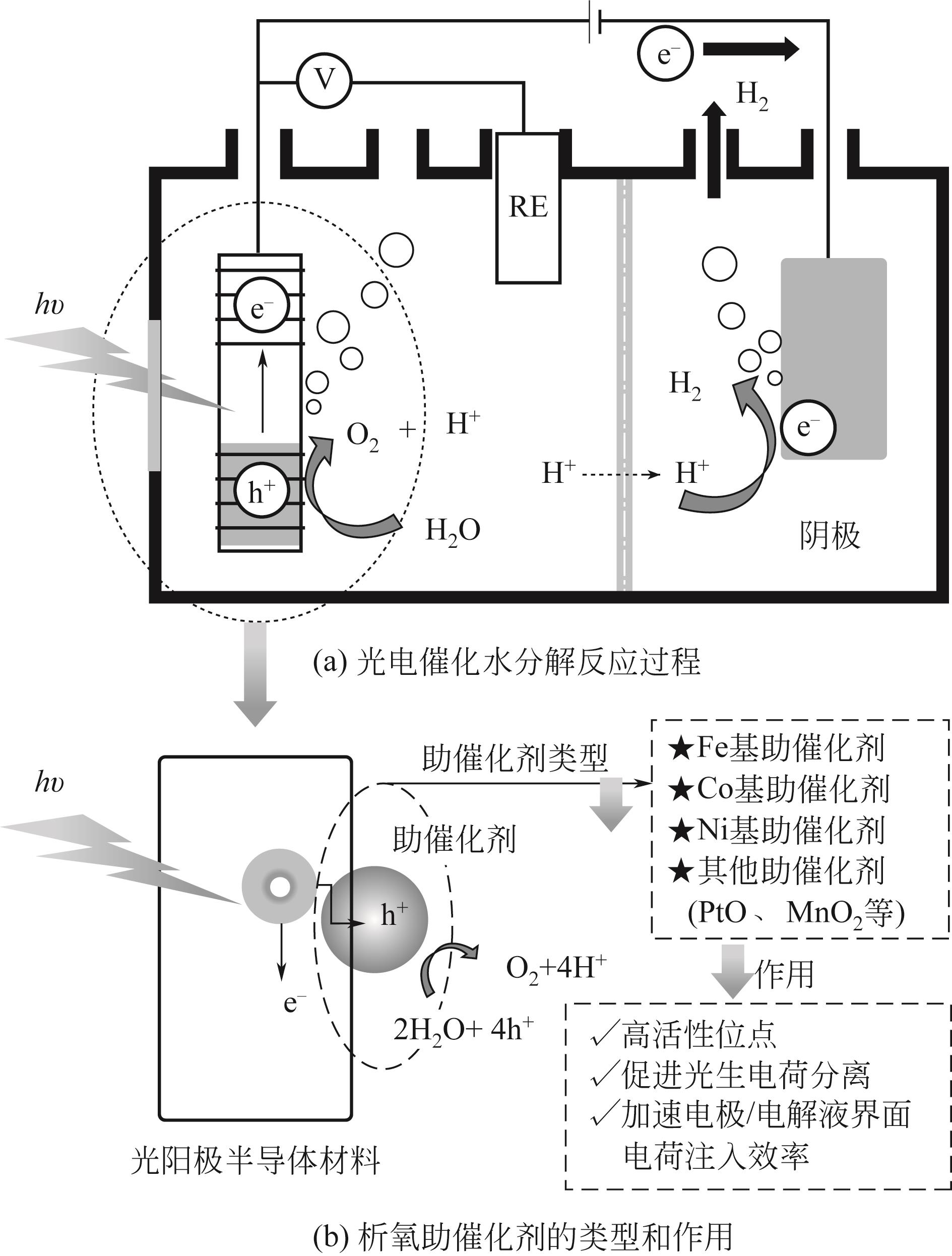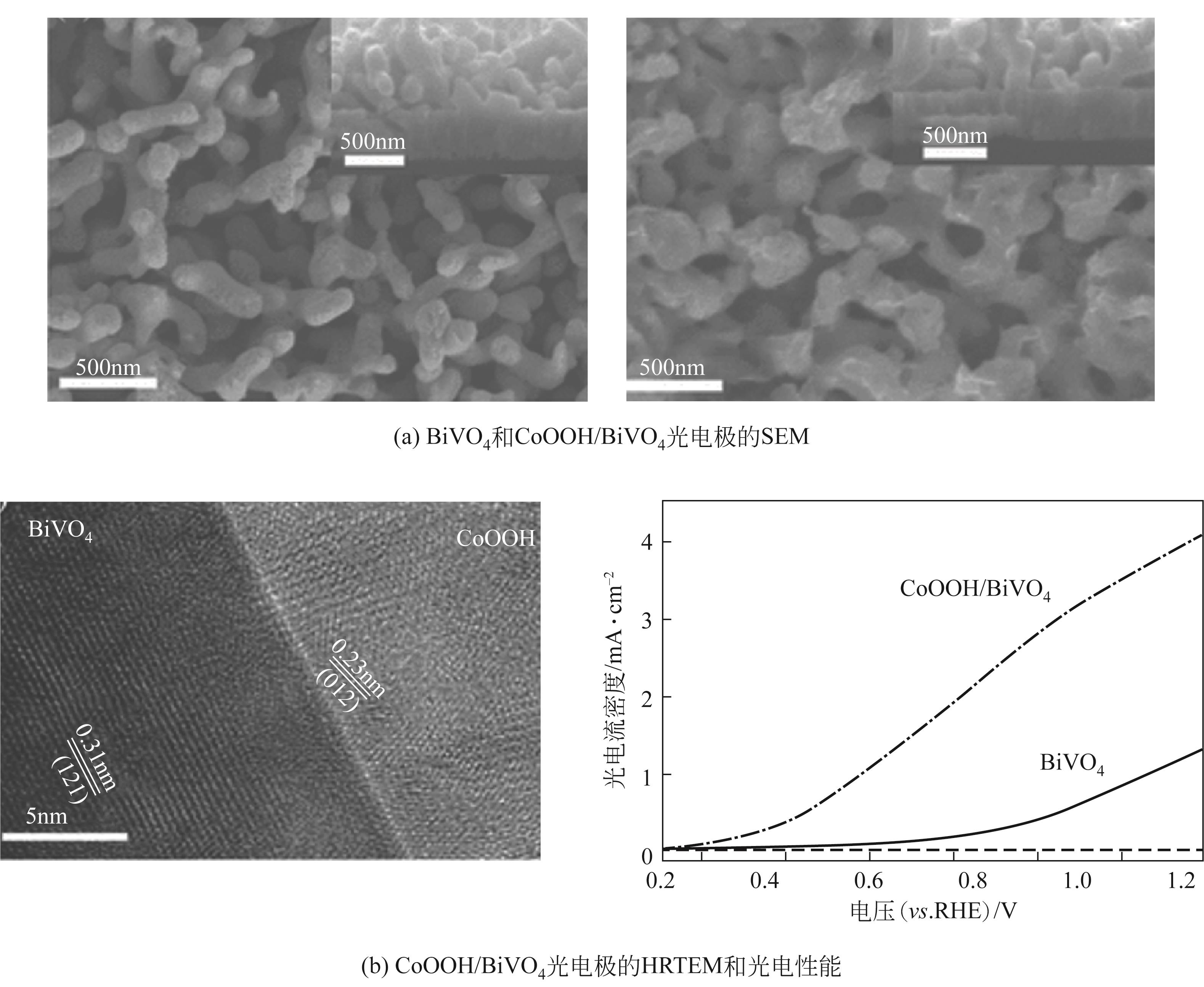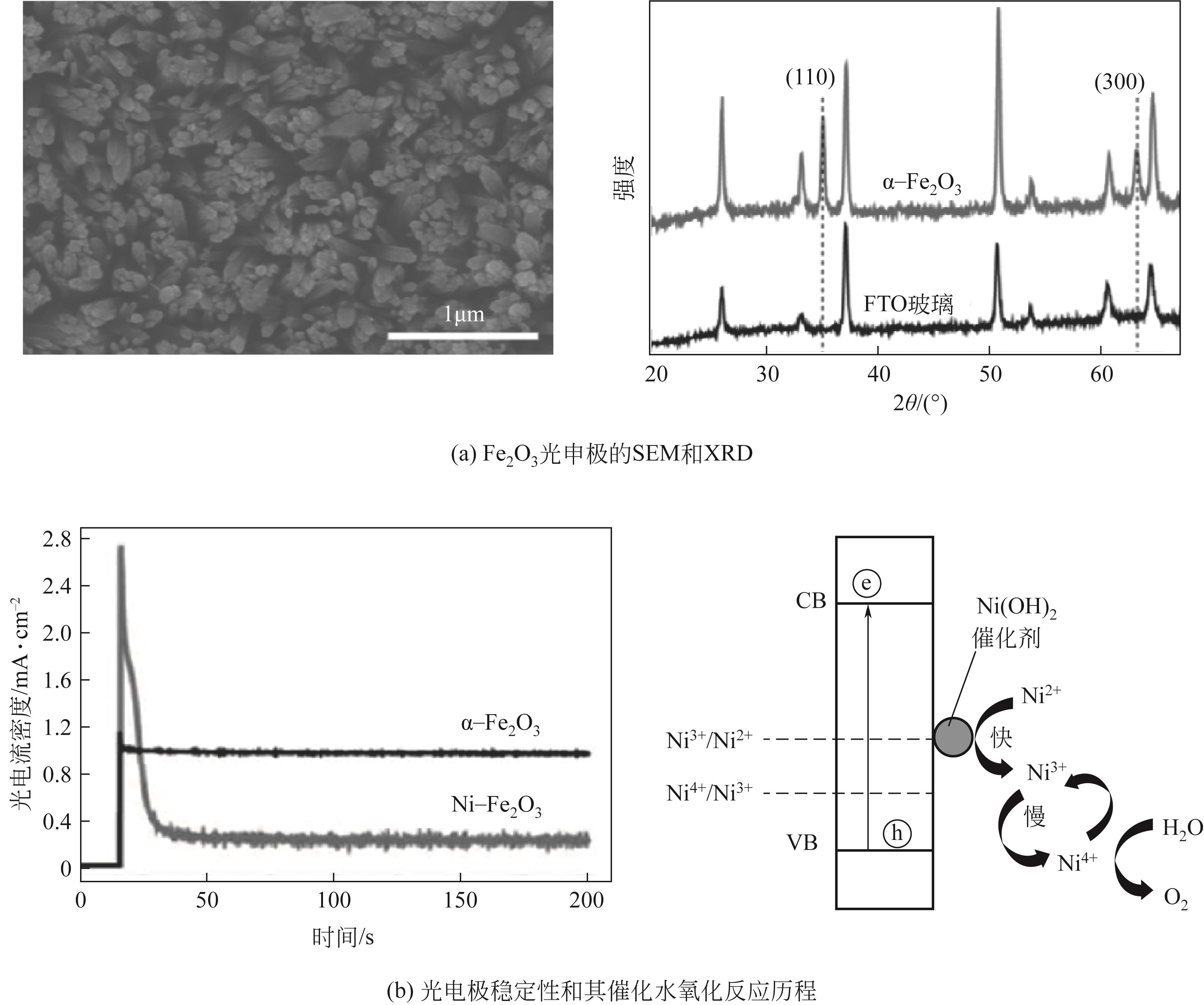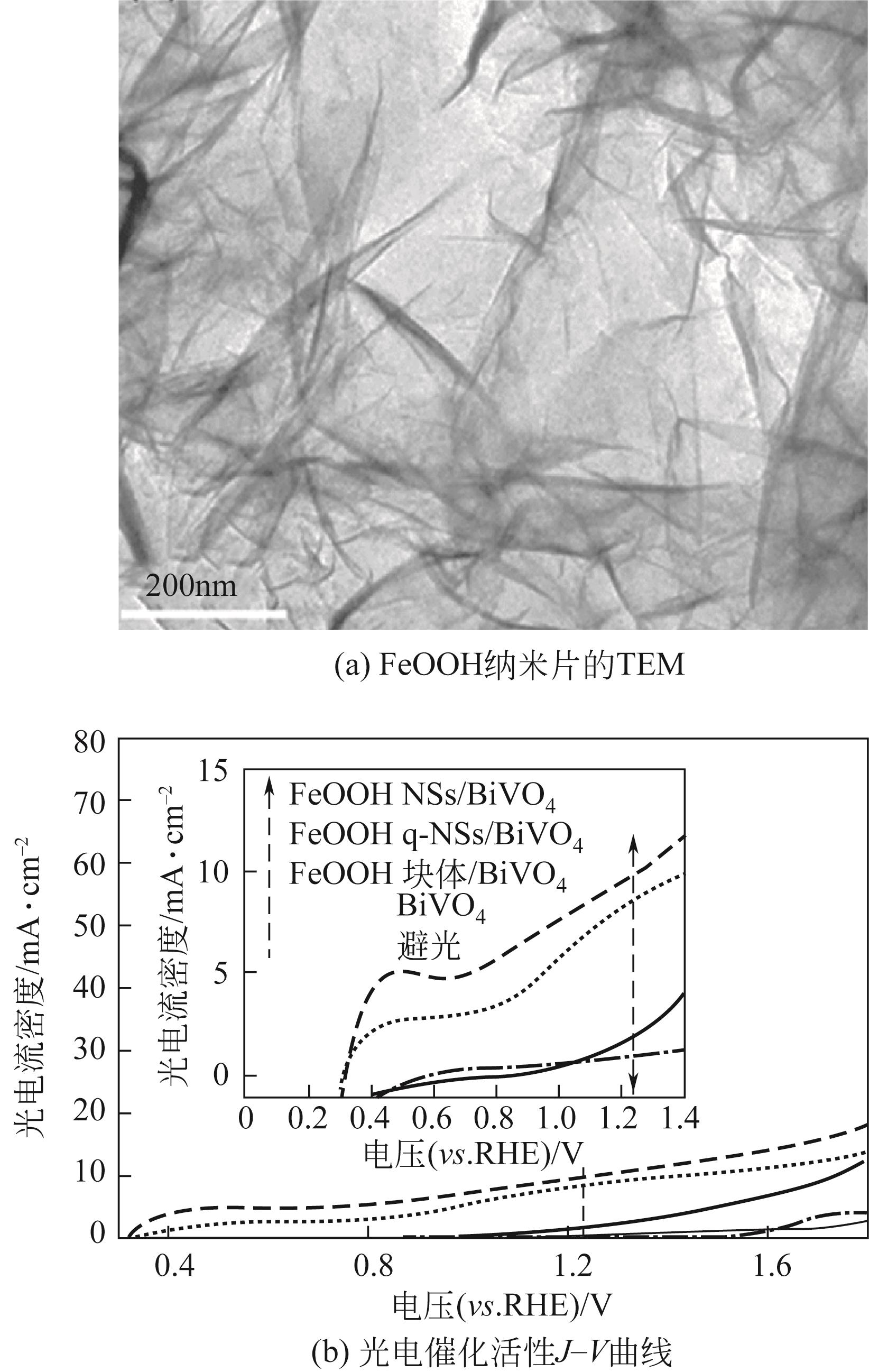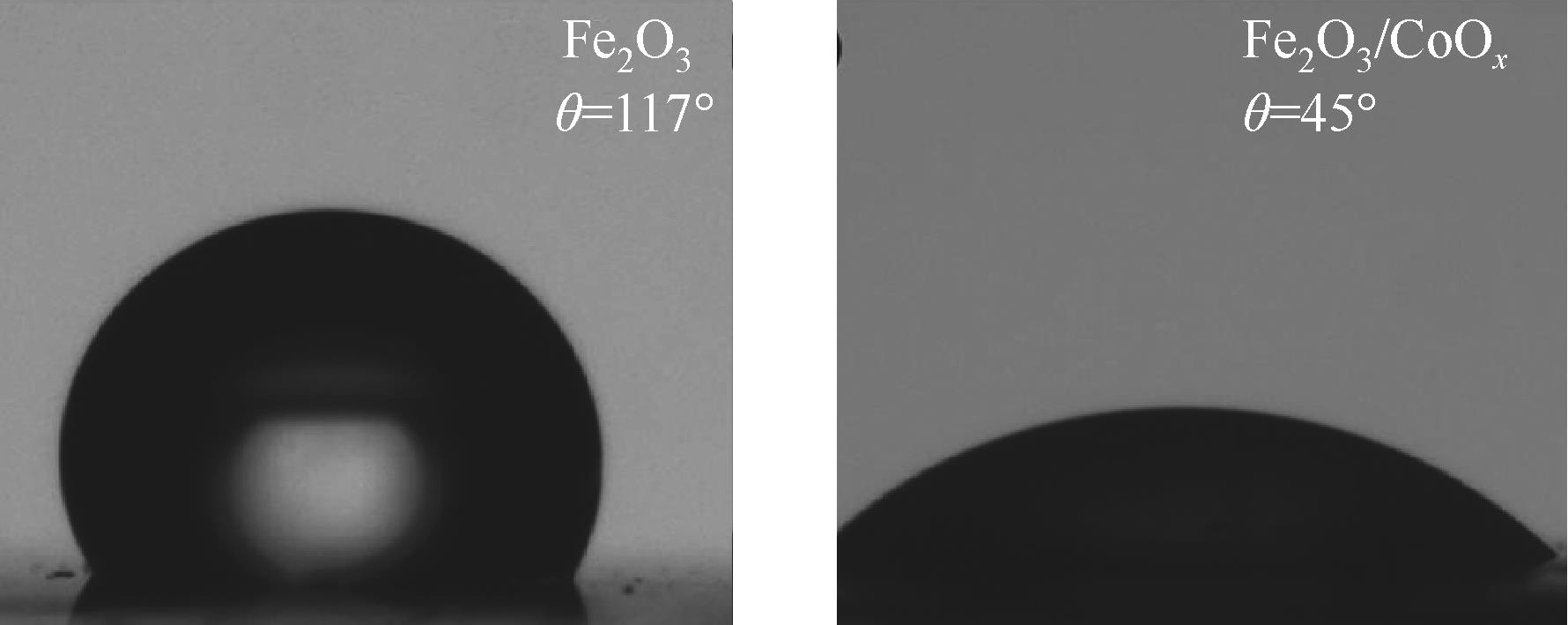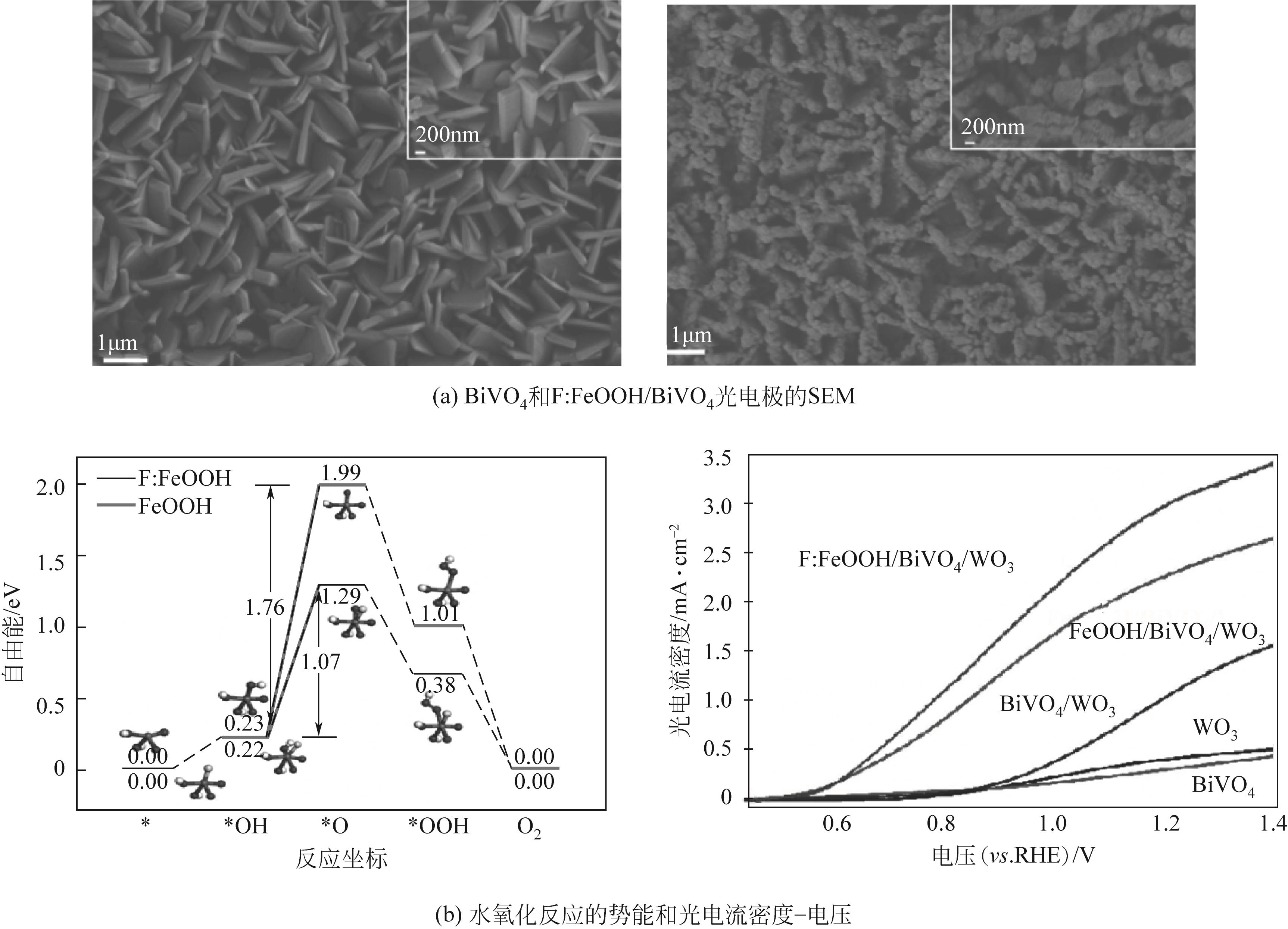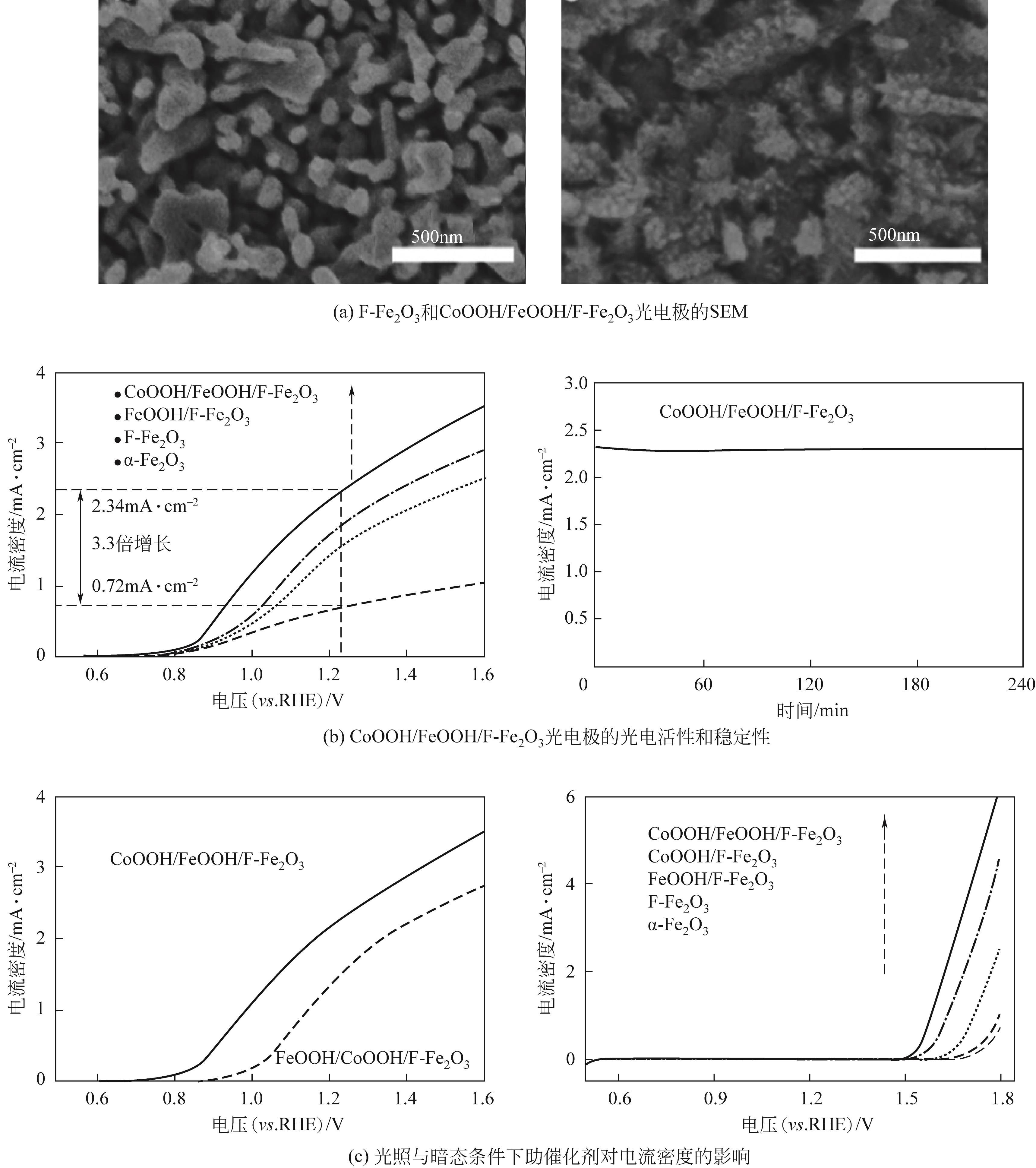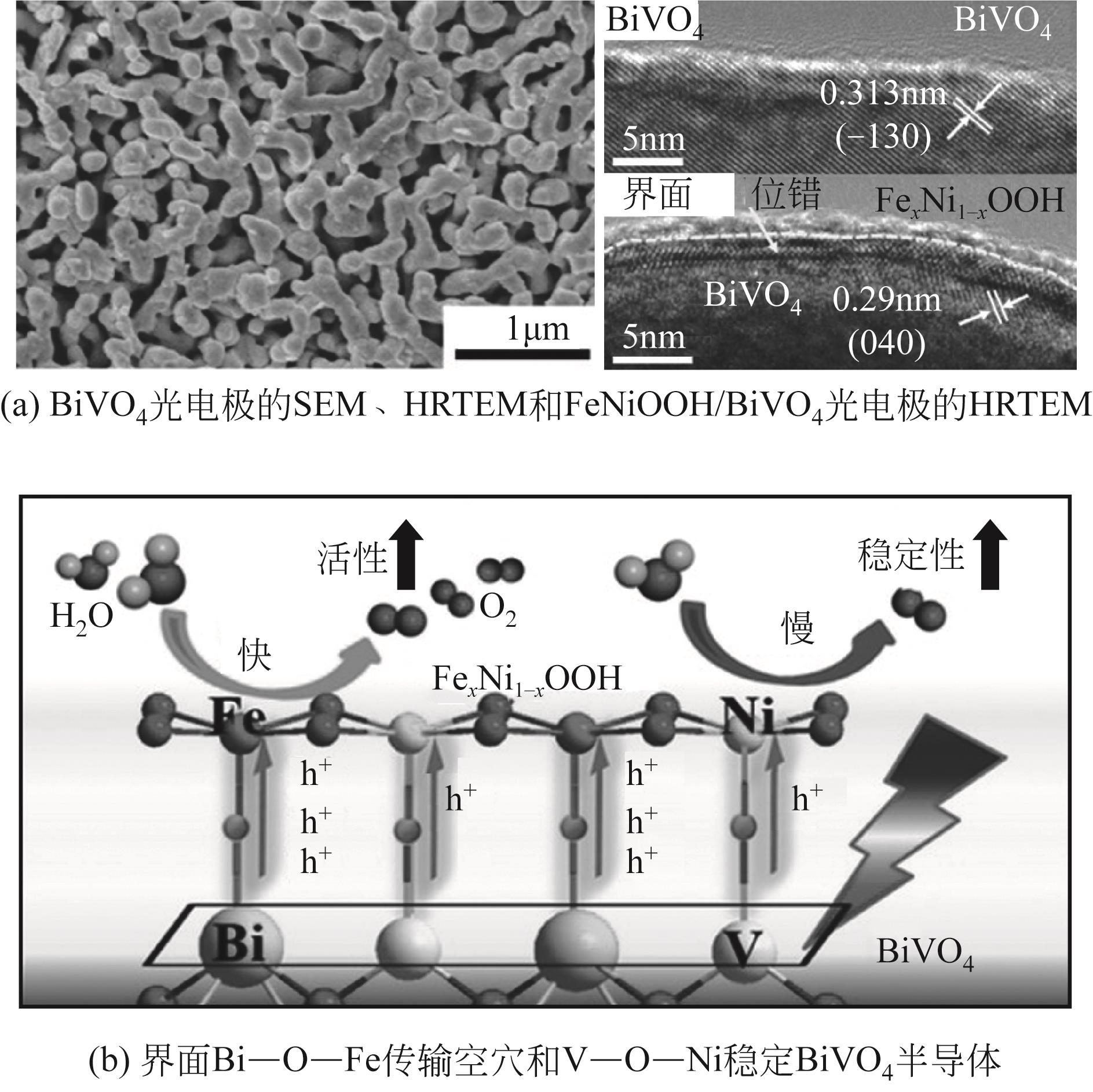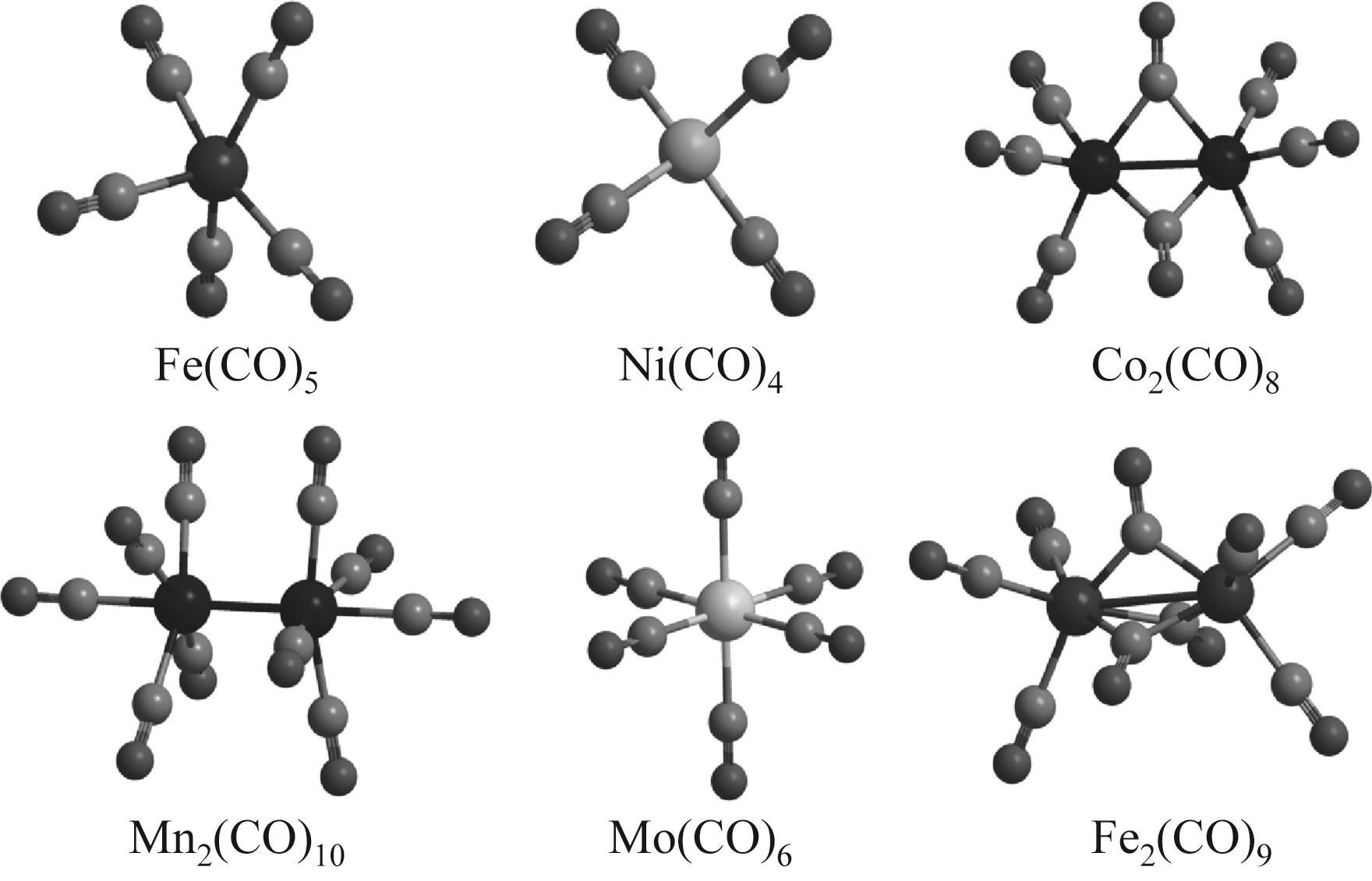Chemical Industry and Engineering Progress ›› 2023, Vol. 42 ›› Issue (5): 2353-2370.DOI: 10.16085/j.issn.1000-6613.2022-1322
• Industrial catalysis • Previous Articles Next Articles
Oxygen evolution cocatalyst enhancing the photoanode performances for photoelectrochemical water splitting
FU Shurong1( ), WANG Lina1, WANG Dongwei2, LIU Rui2, ZHANG Xiaohui2, MA Zhanwei2(
), WANG Lina1, WANG Dongwei2, LIU Rui2, ZHANG Xiaohui2, MA Zhanwei2( )
)
- 1.School of Bailie Mechanical Engineering, Lanzhou City University, Lanzhou 730070, Gansu, China
2.Lanzhou Institute of Chemical Physics, Chinese Academy of Sciences, Lanzhou 730000, Gansu, China
-
Received:2022-07-14Revised:2022-09-07Online:2023-06-02Published:2023-05-10 -
Contact:FU Shurong, MA Zhanwei
析氧助催化剂增强光阳极光电催化分解水性能研究进展
符淑瑢1( ), 王丽娜1, 王东伟2, 刘蕊2, 张晓慧2, 马占伟2(
), 王丽娜1, 王东伟2, 刘蕊2, 张晓慧2, 马占伟2( )
)
- 1.兰州城市学院培黎机械工程学院,甘肃 兰州 730070
2.中国科学院兰州化学物理研究所,甘肃 兰州 730000
-
通讯作者:符淑瑢,马占伟 -
作者简介:符淑瑢(1990—),女,博士,副教授,研究方向为光电催化。E-mail:shurongfu@126.com。 -
基金资助:甘肃省科技计划(21JR7RA542);甘肃省教育厅创新基金(2022A-142);国家自然科学基金(22102194)
CLC Number:
Cite this article
FU Shurong, WANG Lina, WANG Dongwei, LIU Rui, ZHANG Xiaohui, MA Zhanwei. Oxygen evolution cocatalyst enhancing the photoanode performances for photoelectrochemical water splitting[J]. Chemical Industry and Engineering Progress, 2023, 42(5): 2353-2370.
符淑瑢, 王丽娜, 王东伟, 刘蕊, 张晓慧, 马占伟. 析氧助催化剂增强光阳极光电催化分解水性能研究进展[J]. 化工进展, 2023, 42(5): 2353-2370.
share this article
Add to citation manager EndNote|Ris|BibTeX
URL: https://hgjz.cip.com.cn/EN/10.16085/j.issn.1000-6613.2022-1322
| 序号 | 光阳极 | 电解液 | 光源 | 偏压 | 光电流密度/mA·cm-2 | 参考文献 |
|---|---|---|---|---|---|---|
| 1 | FeOOH/BiVO4 | 0.1mol/L KH2PO4 | AM 1.5G,100mW/cm2 | 1.2VRHE | 1.7 | [ |
| 2 | FeOOH QDs/ZnO | 0.1mol/L磷酸盐缓冲液(pH=7) | AM 1.5G,100mW/cm2 | 1.23VRHE | 0.44 | [ |
| 3 | FeOOH/H-TiO2 | 1mol/L NaOH | AM 1.5G,100mW/cm2 | 1.23VRHE | 0.6 | [ |
| 4 | α-FeOOH晶体/BiVO4 | 0.2mol/L Na2SO4 | AM 1.5G,100mW/cm2 | 1.23VRHE | 2.64 | [ |
| 5 | β-FeOOH/BiVO4 | 0.2mol/L Na2SO4 | AM 1.5G,100mW/cm2 | 1.23VRHE | 4.3 | [ |
| 6 | FeP/Ti-Fe2O3 | 1mol/L KOH | AM 1.5G,100mW/cm2 | 1.23VRHE | 3.9 | [ |
| 7 | FeF x /Fe2O3 | 1mol/L KOH | AM 1.5G,100mW/cm2 | 1.23VRHE | 2.4 | [ |
| 8 | CoOOH/BiVO4 | 0.5mol/L Na2SO4+0.2mol/L K3PO4 | AM 1.5G,100mW/cm2 | 1.23VRHE | 4.0 | [ |
| 9 | CoOOH/TiO2 | 1mol/L KOH | AM 1.5G,100mW/cm2 | 1.23VRHE | 1.3 | [ |
| 10 | CoP/BiVO4 | 硼酸盐缓冲液 | AM 1.5G,100mW/cm2 | 1.23VRHE | 4.0 | [ |
| 11 | CoP/Fe2O3 | 1mol/L NaOH | AM 1.5G,100mW/cm2 | 1.23VRHE | 3.54 | [ |
| 12 | MnO2/TiO2 | 1mol/L NaOH | AM 1.5G,100mW/cm2 | 1.23VRHE | 1.95 | [ |
| 13 | PtO/ZnO | 0.2mol/L Na2SO4 | AM 1.5G,100mW/cm2 | 1.23VRHE | 2.3 | [ |
| 14 | CeO x /Fe2O3 | 1mol/LNaOH | AM 1.5G,100mW/cm2 | 1.23VRHE | 0.6 | [ |
| 15 | NiCo2O4/Mo:BiVO4 | 0.5mol/L KH2PO4 | AM 1.5G,100mW/cm2 | 1.23VRHE | 4.5 | [ |
| 16 | CoNiO2/BiVO4 | 0.5mol/L Na2SO4 | 500W Xenon lamps | 1.23VRHE | 1.16 | [ |
| 17 | NiFeOOH/BiVO4 | 0.5mol/L K3BO3 | AM 1.5G,100mW/cm2 | 1.23VRHE | 5.8 | [ |
| 18 | FeCoW/W:BiVO4 | 1mol/L NaOH | AM 1.5G,100mW/cm2 | 1.23VRHE | 0.49 | [ |
| 19 | CoFePi/Ti-Fe2O3 | 0.1mol/L KOH | AM 1.5G,100mW/cm2 | 1.23VRHE | 1.75 | [ |
| 20 | FeOOH/Ag/BiVO4 | 0.1mol/L磷酸盐缓冲液(pH=7) | AM 1.5G,100mW/cm2 | 1.23VRHE | 3.19 | [ |
| 21 | NiOOH/FeOOH/CQD/BiVO4 | KH2PO4 | AM 1.5G,100mW/cm2 | 1.23VRHE | 5.99 | [ |
| 22 | NiOOH/ZnWO4/ZnO | 0.02mol/L KOH | AM 1.5G,100mW/cm2 | 1.23VRHE | 1.7 | [ |
| 23 | NiOOH/FeOOH/BiVO4/rGO/V2O5 | 0.5mol/L Na2SO4 | AM 1.5G,100mW/cm2 | 1.5VAg/AgCl | 3.06 | [ |
| 序号 | 光阳极 | 电解液 | 光源 | 偏压 | 光电流密度/mA·cm-2 | 参考文献 |
|---|---|---|---|---|---|---|
| 1 | FeOOH/BiVO4 | 0.1mol/L KH2PO4 | AM 1.5G,100mW/cm2 | 1.2VRHE | 1.7 | [ |
| 2 | FeOOH QDs/ZnO | 0.1mol/L磷酸盐缓冲液(pH=7) | AM 1.5G,100mW/cm2 | 1.23VRHE | 0.44 | [ |
| 3 | FeOOH/H-TiO2 | 1mol/L NaOH | AM 1.5G,100mW/cm2 | 1.23VRHE | 0.6 | [ |
| 4 | α-FeOOH晶体/BiVO4 | 0.2mol/L Na2SO4 | AM 1.5G,100mW/cm2 | 1.23VRHE | 2.64 | [ |
| 5 | β-FeOOH/BiVO4 | 0.2mol/L Na2SO4 | AM 1.5G,100mW/cm2 | 1.23VRHE | 4.3 | [ |
| 6 | FeP/Ti-Fe2O3 | 1mol/L KOH | AM 1.5G,100mW/cm2 | 1.23VRHE | 3.9 | [ |
| 7 | FeF x /Fe2O3 | 1mol/L KOH | AM 1.5G,100mW/cm2 | 1.23VRHE | 2.4 | [ |
| 8 | CoOOH/BiVO4 | 0.5mol/L Na2SO4+0.2mol/L K3PO4 | AM 1.5G,100mW/cm2 | 1.23VRHE | 4.0 | [ |
| 9 | CoOOH/TiO2 | 1mol/L KOH | AM 1.5G,100mW/cm2 | 1.23VRHE | 1.3 | [ |
| 10 | CoP/BiVO4 | 硼酸盐缓冲液 | AM 1.5G,100mW/cm2 | 1.23VRHE | 4.0 | [ |
| 11 | CoP/Fe2O3 | 1mol/L NaOH | AM 1.5G,100mW/cm2 | 1.23VRHE | 3.54 | [ |
| 12 | MnO2/TiO2 | 1mol/L NaOH | AM 1.5G,100mW/cm2 | 1.23VRHE | 1.95 | [ |
| 13 | PtO/ZnO | 0.2mol/L Na2SO4 | AM 1.5G,100mW/cm2 | 1.23VRHE | 2.3 | [ |
| 14 | CeO x /Fe2O3 | 1mol/LNaOH | AM 1.5G,100mW/cm2 | 1.23VRHE | 0.6 | [ |
| 15 | NiCo2O4/Mo:BiVO4 | 0.5mol/L KH2PO4 | AM 1.5G,100mW/cm2 | 1.23VRHE | 4.5 | [ |
| 16 | CoNiO2/BiVO4 | 0.5mol/L Na2SO4 | 500W Xenon lamps | 1.23VRHE | 1.16 | [ |
| 17 | NiFeOOH/BiVO4 | 0.5mol/L K3BO3 | AM 1.5G,100mW/cm2 | 1.23VRHE | 5.8 | [ |
| 18 | FeCoW/W:BiVO4 | 1mol/L NaOH | AM 1.5G,100mW/cm2 | 1.23VRHE | 0.49 | [ |
| 19 | CoFePi/Ti-Fe2O3 | 0.1mol/L KOH | AM 1.5G,100mW/cm2 | 1.23VRHE | 1.75 | [ |
| 20 | FeOOH/Ag/BiVO4 | 0.1mol/L磷酸盐缓冲液(pH=7) | AM 1.5G,100mW/cm2 | 1.23VRHE | 3.19 | [ |
| 21 | NiOOH/FeOOH/CQD/BiVO4 | KH2PO4 | AM 1.5G,100mW/cm2 | 1.23VRHE | 5.99 | [ |
| 22 | NiOOH/ZnWO4/ZnO | 0.02mol/L KOH | AM 1.5G,100mW/cm2 | 1.23VRHE | 1.7 | [ |
| 23 | NiOOH/FeOOH/BiVO4/rGO/V2O5 | 0.5mol/L Na2SO4 | AM 1.5G,100mW/cm2 | 1.5VAg/AgCl | 3.06 | [ |
| 1 | FUJISHIMA AKIRA, HONDA KENICHI. Electrochemical photolysis of water at a semiconductor electrode[J]. Nature, 1972, 238(5358): 37-38. |
| 2 | 符淑瑢, 张勤生, 鲁金芝, 等. ZnO基光电极的构筑及其光电催化水分解性能研究进展[J]. 化工进展, 2021, 40(3): 1413-1424. |
| FU Shurong, ZHANG Qinsheng, LU Jinzhi, et al. Research progress of fabrication of ZnO-based photoanode and photoelectrocatalytic water splitting performances[J]. Chemical Industry and Engineering Progress, 2021, 40(3): 1413-1424. | |
| 3 | LEE Joo-Won, CHO Ki-Hyun, YOON Joon-Soo, et al. Photoelectrochemical water splitting using one-dimensional nanostructures[J]. Journal of Materials Chemistry A, 2021, 9(38): 21576-21606. |
| 4 | 张文华, 佃丽雯, 陈海燕, 等. 氧化钨(WO3)薄膜光电催化性能的改善及应用[J]. 化工进展, 2020, 39(2): 521-532. |
| ZHANG Wenhua, DIAN Liwen, CHEN Haiyan, et al. Improvement on the photoelectrocatalytic performance of tungsten oxide (WO3) thin film and its application prospects[J]. Chemical Industry and Engineering Progress, 2020, 39(2): 521-532. | |
| 5 | GRIMAUD Alexis, Oscar DIAZ-MORALES, HAN Binghong, et al. Activating lattice oxygen redox reactions in metal oxides to catalyse oxygen evolution[J]. Nature Chemistry, 2017, 9(5): 457-465. |
| 6 | DING Chunmei, SHI Jingying, WANG Zhiliang, et al. Photoelectrocatalytic water splitting: Significance of cocatalysts, electrolyte, and interfaces[J]. ACS Catalysis, 2017, 7(1): 675-688. |
| 7 | ZHONG Miao, HISATOMI Takashi, KUANG Yongbo, et al. Surface modification of CoO x loaded BiVO4 photoanodes with ultrathin p-type NiO layers for improved solar water oxidation[J]. Journal of the American Chemical Society, 2015, 137(15): 5053-5060. |
| 8 | David TILLEY S, CORNUZ Maurin, SIVULA Kevin, et al. Light-induced water splitting with hematite: Improved nanostructure and iridium oxide catalysis[J]. Angewandte Chemie, 2010, 122(36): 6549-6552. |
| 9 | YANG Jinhui, Walczak Karl, Anzenberg Eitan, et al. Efficient and sustained photoelectrochemical water oxidation by cobalt oxide/silicon photoanodes with nanotextured interfaces[J]. Journal of the American Chemical Society, 2014, 136(17): 6191-6194. |
| 10 | David TILLEY S, SCHREIER Marcel, AZEVEDO João, et al. Ruthenium oxide hydrogen evolution catalysis on composite cuprous oxide water-splitting photocathodes[J]. Advanced Functional Materials, 2014, 24(3): 303-311. |
| 11 | CHEMELEWSKI William D, LEE Heung-Chan, LIN Jung-Fu, et al. Amorphous FeOOH oxygen evolution reaction catalyst for photoelectrochemical water splitting[J]. Journal of the American Chemical Society, 2014, 136(7): 2843-2850. |
| 12 | SEABOLD Jason A, CHOI Kyoung-Shin. Efficient and stable photo-oxidation of water by a bismuth vanadate photoanode coupled with an iron oxyhydroxide oxygen evolution catalyst[J]. Journal of the American Chemical Society, 2012, 134(4): 2186-2192. |
| 13 | ZHAN Faqi, YANG Yahui, LIU Wenhua, et al. Facile synthesis of FeOOH quantum dots modified ZnO nanorods films via a metal-solating process[J]. ACS Sustainable Chemistry & Engineering, 2018, 6(6): 7789-7798. |
| 14 | PANZERI G, DELL’ORO R, PANZERI A, et al. FeOOH modified H-TiO2 nanorods array (NRA) for stable and improved low-bias photoelectrochemical water splitting[J]. Journal of the Electrochemical Society, 2021, 168(8): 086505. |
| 15 | ZHANG Wen, MA Jiani, XIONG Lunqiao, et al. Well-crystallized α-FeOOH cocatalysts modified BiVO4 photoanodes for efficient and stable photoelectrochemical water splitting[J]. ACS Applied Energy Materials, 2020, 3(6): 5927-5936. |
| 16 | ZHANG Beibei, WANG Lei, ZHANG Yajun, et al. Ultrathin FeOOH nanolayers with abundant oxygen vacancies on BiVO4 photoanodes for efficient water oxidation[J]. Angewandte Chemie International Edition, 2018, 57(8): 2248-2252. |
| 17 | LUO Wenjun, JIANG Chaoran, LI Yaomin, et al. Highly crystallized α-FeOOH for a stable and efficient oxygen evolution reaction[J]. Journal of Materials Chemistry A, 2017, 5(5): 2021-2028. |
| 18 | XIONG Dehua, LI Wei, WANG Xiaoguang, et al. Passivation of hematite nanorod photoanodes with a phosphorus overlayer for enhanced photoelectrochemical water oxidation[J]. Nanotechnology, 2016, 27(37): 375401. |
| 19 | BU Qijing, LI Shuo, WU Qiannan, et al. In situ synthesis of FeP-decorated Ti-Fe2O3: An effective strategy to improve the interfacial charge transfer in the photoelectrochemical water oxidation reaction[J]. Catalysis Science & Technology, 2019, 9(20): 5812-5818. |
| 20 | FENG Chenchen, WANG Lei, FU Shurong, et al. Ultrathin FeF x nanolayers accelerating hole transfer for enhanced photoelectrochemical water oxidation[J]. Journal of Materials Chemistry A, 2018, 6(40): 19342-19346. |
| 21 | WANG Youwei, QIU Wujie, SONG Erhong, et al. Adsorption-energy-based activity descriptors for electrocatalysts in energy storage applications[J]. National Science Review, 2018, 5(3): 327-341. |
| 22 | ZHONG Diane K, SUN Jianwei, INUMARU Hiroki, et al. Solar water oxidation by composite catalyst/α-Fe2O3 photoanodes[J]. Journal of the American Chemical Society, 2009, 131(17): 6086-6087. |
| 23 | ZHONG Diane K, CHOI Sujung, GAMELIN Daniel R. Near-complete suppression of surface recombination in solar photoelectrolysis by “Co-Pi” catalyst-modified W: BiVO4 [J]. Journal of the American Chemical Society, 2011, 133(45): 18370-18377. |
| 24 | NELLIST Michael, QIU Jingjing, LASKOWSKI Forrest A L, et al. Potential-sensing electrochemical AFM shows CoPi as a hole collector and oxygen evolution catalyst on BiVO4 water-splitting photoanodes[J]. ACS Energy Letters, 2018, 3(9): 2286-2291. |
| 25 | DING Chunmei, SHI Jingying, WANG Donge, et al. Visible light driven overall water splitting using cocatalyst/BiVO4 photoanode with minimized bias[J]. Physical Chemistry Chemical Physics, 2013, 15(13): 4589-4595. |
| 26 | LIAO Maijia, FENG Jianyong, LUO Wenjun, et al. Co3O4 nanoparticles as robust water oxidation catalysts towards remarkably enhanced photostability of a Ta3N5 photoanode[J]. Advanced Functional Materials, 2012, 22(14): 3066-3074. |
| 27 | BERGMANN Arno, Elias MARTINEZ-MORENO, TESCHNER Detre, et al. Reversible amorphization and the catalytically active state of crystalline Co3O4 during oxygen evolution[J]. Nature Communications, 2015, 6(1): 8625. |
| 28 | YANG Jinhui, COOPER Jason K, TOMA Francesca M, et al. A multifunctional biphasic water splitting catalyst tailored for integration with high-performance semiconductor photoanodes[J]. Nature Materials, 2017, 16(3): 335-341. |
| 29 | WANG Pengpeng, FU Ping, MA Jiangping, et al. Ultrathin cobalt oxide interlayer facilitated hole storage for sustained water oxidation over composited tantalum nitride photoanodes[J]. ACS Catalysis, 2021, 11(20): 12736-12744. |
| 30 | WANG Hsin-Yi, HUNG Sung-Fu, CHEN Hanyi, et al. In operando identification of geometrical-site-dependent water oxidation activity of spinel Co3O4 [J]. Journal of the American Chemical Society, 2016, 138(1): 36-39. |
| 31 | TANG Fumin, CHENG Weiren, SU Hui, et al. Smoothing surface trapping states in 3D coral-like CoOOH-wrapped-BiVO4 for efficient photoelectrochemical water oxidation[J]. ACS Applied Materials & Interfaces, 2018, 10(7): 6228-6234. |
| 32 | REN Xiangrong, JI Yujin, ZHAI Yiyue, et al. Self-assembled CoOOH on TiO2 for enhanced photoelectrochemical water oxidation[J]. Journal of Energy Chemistry, 2021, 60: 512-521. |
| 33 | TONG Haili, JIANG Yi, ZHANG Qian, et al. Boosting photoelectrochemical water oxidation with cobalt phosphide nanosheets on porous BiVO4 [J]. ACS Sustainable Chemistry & Engineering, 2019, 7(1): 769-778. |
| 34 | KIM Jin Hyun, HAN Suenghoon, Yim Hyun JO, et al. A precious metal-free solar water splitting cell with a bifunctional cobalt phosphide electrocatalyst and doubly promoted bismuth vanadate photoanode[J]. Journal of Materials Chemistry A, 2018, 6(3): 1266-1274. |
| 35 | JIANG Daochuan, ZHANG Lei, YUE Qiudi, et al. Efficient suppression of surface charge recombination by CoP-modified nanoporous BiVO4 for photoelectrochemical water splitting[J]. International Journal of Hydrogen Energy, 2021, 46(29): 15517-15525. |
| 36 | QUANG Nguyen Duc, HU Weiguang, CHANG Hyo Sik, et al. Fe2O3 hierarchical tubular structure decorated with cobalt phosphide (CoP) nanoparticles for efficient photoelectrochemical water splitting[J]. Chemical Engineering Journal, 2021, 417: 129278. |
| 37 | MA Yuli, HU Yun hang. Efficient Ni(OH)2/WO3 photoanode for photoelectrocatalytic water splitting at low bias[J]. The Journal of Physical Chemistry C, 2020, 124(36): 19447-19456. |
| 38 | XU Dandan, FU Zewen, WANG Dejun, et al. A Ni(OH)2-modified Ti-doped α-Fe2O3 photoanode for improved photoelectrochemical oxidation of urea: The role of Ni(OH)2 as a cocatalyst[J]. Physical Chemistry Chemical Physics, 2015, 17(37): 23924-23930. |
| 39 | WANG Gongming, LING Yichuan, LU Xihong, et al. A mechanistic study into the catalytic effect of Ni(OH)2 on hematite for photoelectrochemical water oxidation[J]. Nanoscale, 2013, 5(10): 4129-4133. |
| 40 | MALARA Francesco, MINGUZZI Alessandro, MARELLI Marcello, et al. α-Fe2O3/NiOOH: An effective heterostructure for photoelectrochemical water oxidation[J]. ACS Catalysis, 2015, 5(9): 5292-5300. |
| 41 | RONG Jiayue, WANG Zhenzhen, LV Jiaqi, et al. Ni(OH)2 quantum dots as a stable cocatalyst modified α-Fe2O3 for enhanced photoelectrochemical water-splitting[J]. Chinese Journal of Catalysis, 2021, 42(11): 1999-2009. |
| 42 | QIU Ping, LI Fei, ZHANG Hongda, et al. Photoelectrochemical performance of α-Fe2O3@NiOOH fabricated with facile photo-assisted electrodeposition method[J]. Electrochimica Acta, 2020, 358: 136847. |
| 43 | ZHUANG Changwan, SONG Zhiyuan, YU Zhuobin, et al. Photoelectrochemical performance of TiO2 nanotube arrays modified with Ni2P co-catalyst[J]. International Journal of Hydrogen Energy, 2021, 46(7): 4981-4991. |
| 44 | WEN Peng, SU Feijing, LI Hui, et al. A Ni2P nanocrystal cocatalyst enhanced TiO2 photoanode towards highly efficient photoelectrochemical water splitting[J]. Chemical Engineering Journal, 2020, 385: 123878. |
| 45 | CHENG Xiang, DONG Guojun, ZHANG Yajun, et al. Dual-bonding interactions between MnO2 cocatalyst and TiO2 photoanodes for efficient solar water splitting[J]. Applied Catalysis B: Environmental, 2020, 267: 118723. |
| 46 | FU Shurong, ZHANG Beibei, HU Hongyan, et al. ZnO nanowire arrays decorated with PtO nanowires for efficient solar water splitting[J]. Catalysis Science & Technology, 2018, 8(11): 2789-2793. |
| 47 | AHMED Mahmoud G, ZHANG Mengyuan, Ying Fan TAY, et al. Surface modification of hematite photoanodes with CeO x cocatalyst for improved photoelectrochemical water oxidation kinetics[J]. ChemSusChem, 2020, 13(20): 5489-5496. |
| 48 | FENG Chenchen, ZHOU Qi, ZHENG Bin, et al. Ultrathin NiCo2O4 nanosheets with dual-metal active sites for enhanced solar water splitting of a BiVO4 photoanode[J]. Journal of Materials Chemistry A, 2019, 7(39): 22274-22278. |
| 49 | FANG Guozhen, LIU Zhifeng, HAN Changcun, et al. CoNiO2 as a novel water oxidation cocatalyst to enhance PEC water splitting performance of BiVO4 [J]. Chemical Communications, 2020, 56(64): 9158-9161. |
| 50 | LU Yumeng, SU Jinzhan, SHI Jinwen, et al. Surface recombination passivation of the BiVO4 photoanode by the synergistic effect of the cobalt/nickel sulfide cocatalyst[J]. ACS Applied Energy Materials, 2020, 3(9): 9089-9097. |
| 51 | KUANG Yongbo, JIA Qingxin, NISHIYAMA Hiroshi, et al. A front-illuminated nanostructured transparent BiVO4 photoanode for >2% efficient water splitting[J]. Advanced Energy Materials, 2016, 6(2): 1501645. |
| 52 | ZHANG Beibei, HUANG Xiaojuan, ZHANG Yan, et al. Unveiling the activity and stability origin of BiVO4 photoanodes with FeNi oxyhydroxides for oxygen evolution[J]. Angewandte Chemie International Edition, 2020, 59(43): 18990-18995. |
| 53 | ZHAO Fei, LI Na, WU Yun, et al. BiVO4 photoanode decorated with cobalt-manganese layered double hydroxides for enhanced photoelectrochemical water oxidation[J]. International Journal of Hydrogen Energy, 2020, 45: 31902-31912. |
| 54 | FANG Guozhen, LIU Zhifeng, HAN Changcun, et al. Promising CoFe-NiOOH ternary polymetallic cocatalyst for BiVO4-based photoanodes in photoelectrochemical water splitting[J]. ACS Applied Energy Materials, 2021, 4(4): 3842-3850. |
| 55 | ZHANG Bo, ZHENG Xueli, VOZNYY Oleksandr, et al. Homogeneously dispersed multimetal oxygen-evolving catalysts[J]. Science, 2016, 352(6283): 333-337. |
| 56 | LIANG Xiaorong, XIE Jiale, XIONG Jinyun, et al. FeCoW multimetal oxide-coated W: BiVO4 photoanode for efficient oxygen evolution[J]. Sustainable Energy & Fuels, 2018, 2(9): 2053-2059. |
| 57 | GE Ge, LIU Min, LIU Chao, et al. Ultrathin FeOOH nanosheets as an efficient cocatalyst for photocatalytic water oxidation[J]. Journal of Materials Chemistry A, 2019, 7(15): 9222-9229. |
| 58 | DU Chun, WANG Jun, LIU Xiao, et al. Ultrathin CoO x -modified hematite with low onset potential for solar water oxidation[J]. Physical Chemistry Chemical Physics, 2017, 19(21): 14178-14184. |
| 59 | CHOI Min-Ju, KIM Taemin L, CHOI Kyoung Soon, et al. Controlled band offsets in ultrathin hematite for enhancing the photoelectrochemical water splitting performance of heterostructured photoanodes[J]. ACS Applied Materials & Interfaces, 2022, 14(6): 7788-7795. |
| 60 | LIU Guang, ZHAO Yong, YAO Rui, et al. Realizing high performance solar water oxidation for Ti-doped hematite nanoarrays by synergistic decoration with ultrathin cobalt-iron phosphate nanolayers[J]. Chemical Engineering Journal, 2019, 355: 49-57. |
| 61 | LIU Qiong, CAO Fengren, WU Fangli, et al. Ultrathin amorphous Ni(OH)2 nanosheets on ultrathin α-Fe2O3 films for improved photoelectrochemical water oxidation[J]. Advanced Materials Interfaces, 2016, 3(21): 1600256. |
| 62 | YANG Gaoliang, LI Yunxiang, PANG Hong, et al. Ultrathin cobalt-manganese nanosheets: An efficient platform for enhanced photoelectrochemical water oxidation with electron-donating effect[J]. Advanced Functional Materials, 2019, 29(46): 1904622. |
| 63 | YU Xuelian, LIU Jianqiao, YIN Wenchao, et al. Ultrathin NiMn-layered double hydroxide nanosheets coupled with α-Fe2O3 nanorod arrays for photoelectrochemical water splitting[J]. Applied Surface Science, 2019, 492: 264-271. |
| 64 | YI Yunan, WU Qianbao, WANG Wei, et al. In situ depositing an ultrathin CoO x H y layer on hematite in alkaline media for photoelectrochemical water oxidation[J]. Applied Catalysis B: Environmental, 2020, 263: 118334. |
| 65 | LUO Heng, LIU Changhai, XU Yu, et al. An ultra-thin NiOOH layer loading on BiVO4 photoanode for highly efficient photoelectrochemical water oxidation[J]. International Journal of Hydrogen Energy, 2019, 44(57): 30160-30170. |
| 66 | BAO Jian, ZHANG Xiaodong, FAN Bo, et al. Ultrathin spinel-structured nanosheets rich in oxygen deficiencies for enhanced electrocatalytic water oxidation[J]. Angewandte Chemie International Edition, 2015, 54(25): 7399-7404. |
| 67 | ZHANG Beibei, HUANG Xiaojuan, HU Hongyan, et al. Defect-rich and ultrathin CoOOH nanolayers as highly efficient oxygen evolution catalysts for photoelectrochemical water splitting[J]. Journal of Materials Chemistry A, 2019, 7(9): 4415-4419. |
| 68 | SHE Houde, YUE Pengfei, HUANG Jingwei, et al. One-step hydrothermal deposition of F:FeOOH onto BiVO4 photoanode for enhanced water oxidation[J]. Chemical Engineering Journal, 2020, 392: 123703. |
| 69 | LI Yan, MEI Qiong, LIU Zejun, et al. Fluorine-doped iron oxyhydroxide cocatalyst: Promotion on the WO3 photoanode conducted photoelectrochemical water splitting[J]. Applied Catalysis B: Environmental, 2022, 304: 120995. |
| 70 | ALAM Suhaib, SAHU Tushar Kanta, QURESHI Mohammad. One-dimensional Co(OH)F as a noble metal-free redox mediator and hole extractor for boosted photoelectrochemical water oxidation in worm-like bismuth vanadate[J]. ACS Sustainable Chemistry & Engineering, 2021, 9(14): 5155-5165. |
| 71 | GU Xinning, ZHANG Jialing, HOU Liqiong, et al. Dual modification with Ag and FeOOH significantly increased the photoelectrochemical water splitting activity of BiVO4 photoanodes[J]. Surfaces and Interfaces, 2021, 25: 101224. |
| 72 | YE Kaihang, WANG Zilong, GU Jiuwang, et al. Carbon quantum dots as a visible light sensitizer to significantly increase the solar water splitting performance of bismuth vanadate photoanodes[J]. Energy & Environmental Science, 2017, 10(3): 772-779. |
| 73 | NING Fanyu, SHAO Mingfei, XU Simin, et al. TiO2/graphene/NiFe-layered double hydroxide nanorod array photoanodes for efficient photoelectrochemical water splitting[J]. Energy & Environmental Science, 2016, 9(8): 2633-2643. |
| 74 | SUN Lixia, SUN Jianhua, YANG Xiaojun, et al. An integrating photoanode consisting of BiVO4, rGO and LDH for photoelectrochemical water splitting[J]. Dalton Transactions, 2019, 48(42): 16091-16098. |
| 75 | ZENG Guihua, HOU Liqiong, ZHANG Jialing, et al. FeOOH/rGO/BiVO4 photoanode for highly enhanced photoelectrochemical water splitting performance[J]. ChemCatChem, 2020, 12(14): 3769-3775. |
| 76 | FENG Chenchen, FU Han, JIA Henan, et al. Ultrathin Ti3C2 nanosheets served as a highly efficient hole transport layer on a Fe2O3 photoanode for photoelectrochemical water oxidation[J]. New Journal of Chemistry, 2021, 45(44): 20537-20541. |
| 77 | FU Shurong, HU Hongyan, FENG Chenchen, et al. Epitaxial growth of ZnWO4 hole-storage nanolayers on ZnO photoanodes for efficient solar water splitting[J]. Journal of Materials Chemistry A, 2019, 7(6): 2513-2517. |
| 78 | Chong Siang YAW, TANG Junwang, Ai Kah SOH, et al. Synergistic effects of dual-electrocatalyst FeOOH/NiOOH thin films as effective surface photogenerated hole extractors on a novel hierarchical heterojunction photoanode structure for solar-driven photoelectrochemical water splitting[J]. Chemical Engineering Journal, 2020, 380: 122501. |
| 79 | WANG Tong, LONG Xuefeng, WEI Shenqi, et al. Boosting hole transfer in the fluorine-doped hematite photoanode by depositing ultrathin amorphous FeOOH/CoOOH cocatalysts[J]. ACS Applied Materials & Interfaces, 2020, 12(44): 49705-49712. |
| 80 | ISMAIL Ahmed S M, Ivan GARCIA-TORREGROSA, VOLLENBROEK Jeroen C, et al. Detection of spontaneous FeOOH formation at the hematite/Ni(Fe)OOH interface during photoelectrochemical water splitting by operando X-ray absorption spectroscopy[J]. ACS Catalysis, 2021, 11(19): 12324-12335. |
| 81 | DUBALE Amare Aregahegn, SU Wei-Nien, TAMIRAT Andebet Gedamu, et al. The synergetic effect of graphene on Cu2O nanowire arrays as a highly efficient hydrogen evolution photocathode in water splitting[J]. Journal of Materials Chemistry A, 2014, 2(43): 18383-18397. |
| 82 | XU Weiwei, TIAN Wei, MENG Linxing, et al. Interfacial chemical bond-modulated Z-scheme charge transfer for efficient photoelectrochemical water splitting[J]. Advanced Energy Materials, 2021, 11(8): 2003500. |
| 83 | LI Sijie, ZHANG Limin, ZHAO Wenqing, et al. Designing interfacial chemical bonds towards advanced metal-based energy-storage/conversion materials[J]. Energy Storage Materials, 2020, 32: 477-496. |
| [1] | XIE Luyao, CHEN Songzhe, WANG Laijun, ZHANG Ping. Platinum-based catalysts for SO2 depolarized electrolysis [J]. Chemical Industry and Engineering Progress, 2023, 42(S1): 299-309. |
| [2] | HU Xi, WANG Mingshan, LI Enzhi, HUANG Siming, CHEN Junchen, GUO Bingshu, YU Bo, MA Zhiyuan, LI Xing. Research progress on preparation and sodium storage properties of tungsten disulfide composites [J]. Chemical Industry and Engineering Progress, 2023, 42(S1): 344-355. |
| [3] | XU Chunshu, YAO Qingda, LIANG Yongxian, ZHOU Hualong. Research progress on functionalization strategies of covalent organic frame materials and its adsorption properties for Hg(Ⅱ) and Cr(Ⅵ) [J]. Chemical Industry and Engineering Progress, 2023, 42(S1): 461-478. |
| [4] | GE Quanqian, XU Mai, LIANG Xian, WANG Fengwu. Research progress on the application of MOFs in photoelectrocatalysis [J]. Chemical Industry and Engineering Progress, 2023, 42(9): 4692-4705. |
| [5] | ZHANG Yajuan, XU Hui, HU Bei, SHI Xingwei. Preparation of NiCoP/rGO/NF electrocatalyst by eletroless plating for efficient hydrogen evolution reaction [J]. Chemical Industry and Engineering Progress, 2023, 42(8): 4275-4282. |
| [6] | YE Zhendong, LIU Han, LYU Jing, ZHANG Yaning, LIU Hongzhi. Optimization of thermochemical energy storage reactor based on calcium and magnesium binary salt hydrates [J]. Chemical Industry and Engineering Progress, 2023, 42(8): 4307-4314. |
| [7] | WANG Yunqing, YANG Guorui, YAN Wei. Transition metal phosphide modification and its applications in electrochemical hydrogen evolution reaction [J]. Chemical Industry and Engineering Progress, 2023, 42(7): 3532-3549. |
| [8] | LI Jiyan, JING Yanju, XING Guoyu, LIU Meichen, LONG Yong, ZHU Zhaoqi. Research progress and challenges of salt-resistant solar-driven interface photo-thermal materials and evaporator [J]. Chemical Industry and Engineering Progress, 2023, 42(7): 3611-3622. |
| [9] | DU Baoning, ZHAO Shan, LIU Xiangqing, ZHANG Yi, XIAO Yaru, ZHANG Shaofei, LI Tiantian, SUN Jinfeng. Preparation and properties of nano porous CuMn-based oxide electrodes [J]. Chemical Industry and Engineering Progress, 2023, 42(3): 1484-1492. |
| [10] | DU Tao, MA Jinwei, CHEN Qianqian, FANG Hao, CHEN Bingzhang, CHEN Houren. Comparison test and numerical simulation analysis of PV/T module composite cooling mode [J]. Chemical Industry and Engineering Progress, 2023, 42(2): 722-730. |
| [11] | ZHANG He, LI Xiaoke, XIONG Ying, WEN Jin. Desalination and pollution treatment of fracturing flow-back fluid based on interfacial solar evaporation of hydrogel [J]. Chemical Industry and Engineering Progress, 2023, 42(2): 1073-1079. |
| [12] | XU Chunshu, YAO Qingda, LIANG Yongxian, ZHOU Hualong. Structural design of metal-organic framework materials and its adsorption performance on synthetic dyes [J]. Chemical Industry and Engineering Progress, 2023, 42(10): 5322-5338. |
| [13] | ZHANG Huixia, ZHOU Lishan, ZHANG Chenglei, QIAN Guanglei, XIE Chenxin, ZHU Lingzhi. Preparation of Bi2S3/TiO2 nanocone photoanode and their photoelectrocatalysis degradation of hygromycin [J]. Chemical Industry and Engineering Progress, 2023, 42(10): 5548-5557. |
| [14] | XIAO Zhourong, LI Guozhu, WANG Li, ZHANG Xiangwen, GU Jianmin, WANG Desong. Research progress of the catalysts for hydrogen production via liquid hydrocarbon fuels steam reforming [J]. Chemical Industry and Engineering Progress, 2022, 41(S1): 97-107. |
| [15] | HU Bing, XU Lijun, HE Shan, SU Xin, WANG Jiwei. Researching progress of hydrogen production by PEM water electrolysis under the goal of carbon peak and carbon neutrality [J]. Chemical Industry and Engineering Progress, 2022, 41(9): 4595-4604. |
| Viewed | ||||||
|
Full text |
|
|||||
|
Abstract |
|
|||||
